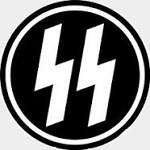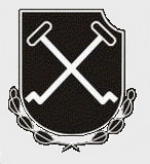Dragon DRR63227 German Late Production Sd. Kfz. 181 PzKpfw VI Tiger I Ausf. E Heavy Tank - SS-Hauptsturmfuhrer Michael Wittmann, "Red 212", schwere SS Panzerabteilung 101, Normandy, France, Summer 1944 (1:72 Scale)
"If the tank succeeds, then victory follows."
- Major-General Heinz Guderian, "Achtung Panzer!"
 The German Waffenamt issued an order to design the VK4501(H) (as the PzKpfw VI Ausf. E was then known) in May 1941, just one month prior to the commencement of Operation Barbarossa. Interestingly, Henschel und Sohn of Kassel was charged with building the heavily armored chassis while Krupp, by far the largest munitionwerks in Germany, was given the task of developing the turret. The PzKpfw VI Ausfuhrung E (type E) was one of the first German tanks to feature a torsion bar with eight interleaved wheels, which was designed to support the weight of the mammoth 57-ton tank. The Ausf. E mounted a huge 8.8cm KwK36 L/56 cannon and featured two MG34 machine guns for close support against enemy infantry. By war's end, 1,354 vehicles had been produced, some rolling off the Wegmann assembly line.
The German Waffenamt issued an order to design the VK4501(H) (as the PzKpfw VI Ausf. E was then known) in May 1941, just one month prior to the commencement of Operation Barbarossa. Interestingly, Henschel und Sohn of Kassel was charged with building the heavily armored chassis while Krupp, by far the largest munitionwerks in Germany, was given the task of developing the turret. The PzKpfw VI Ausfuhrung E (type E) was one of the first German tanks to feature a torsion bar with eight interleaved wheels, which was designed to support the weight of the mammoth 57-ton tank. The Ausf. E mounted a huge 8.8cm KwK36 L/56 cannon and featured two MG34 machine guns for close support against enemy infantry. By war's end, 1,354 vehicles had been produced, some rolling off the Wegmann assembly line.
The Tiger differed from earlier German tanks principally in its design philosophy. Its predecessors balanced mobility, armor and firepower and were sometimes outgunned by their opponents.
While heavy, this tank was not slower than the best of its opponents. However, at over 50 tonnes dead weight, the suspension, gearboxes, and other such items had clearly reached their design limits and breakdowns were frequent if regular maintenance was not undertaken.
Although the general design and layout were broadly similar to the previous medium tank, the Panzer IV, the Tiger weighed more than twice as much. This was due to its substantially thicker armor, the larger main gun, greater volume of fuel and ammunition storage, larger engine, and a more solidly built transmission and suspension.
This particular 1:72 scale late production Tiger I Ausf. E heavy tank was commanded by legendary panzer ace SS-Hauptsturmfuhrer Michael Wittmann, who was attached to schwere SS Panzerabteilung 101, then deployed to Normandy, France, during the summer of 1944.
Now in stock!
Dimensions:
Width: 2-1/4-inches
Length: 4-1/2-inches
Release Date: December 2023
 Historical Account: "The Black Baron" - In November 1943, Wittmann, still serving in the Leibstandarte's heavy tank company, was involved in armored counterattacks against the Russians around Zhitomir. On their first day in action against the Soviets, Wittman's crew destroyed ten T-34s and five anti-tank guns. "By early January 1944 his combined total of destroyed tanks would rise to sixty-six."
Historical Account: "The Black Baron" - In November 1943, Wittmann, still serving in the Leibstandarte's heavy tank company, was involved in armored counterattacks against the Russians around Zhitomir. On their first day in action against the Soviets, Wittman's crew destroyed ten T-34s and five anti-tank guns. "By early January 1944 his combined total of destroyed tanks would rise to sixty-six."
On January 14th, 1944, Wittmann was awarded the Knight's Cross of the Iron Cross. The presentation was made by his divisional commander, SS-Oberfuhrer Theodor Wisch, who nominated him for the Knight's Cross of the Iron Cross with Oak Leaves. Wittmann was awarded the Oak Leaves on January 30th for the destruction of 117 tanks, making him the 380th member of the German armed forces to receive it. He received the award from Adolf Hitler, who presented it to him at the Wolf's Lair, his headquarters in Rastenburg, on February 2nd, 1944.
In April, the LSSAH's Tiger Company was transferred to SS Heavy Panzer Battalion 101. This battalion was assigned to the I SS Panzer Corps as a corps asset, and was never permanently attached to any division or regiment. Wittmann was appointed commander of the battalion's second company, and held the rank of SS-Obersturmfuhrer. On June 7th, the day after the Allied Invasion of Normandy began, the battalion was ordered to move from Beauvais to Normandy. The move, covering 165 km (105 miles), took five days to complete.
Due to the Anglo-American advance south from Gold and Omaha Beaches, the German 352.Infanterie Division began to buckle. As the division withdrew south, it opened a 12 km (a 7.5-mile) gap in the front line near Caumont-l'Evente. Sepp Dietrich, commander of 1.SS Panzer Corps, ordered Heavy SS-Panzer Battalion 101, his only reserve, to position itself behind the Panzer Lehr Division and SS Division Hitlerjugend. From this position, the battalion could protect the developing open left flank. Anticipating the importance the British would assign to the high ground near Villers-Bocage, Wittmann's company was positioned near the town. It arrived late on June 12th. Nominally composed of 12 tanks, his company was 50 per cent under strength due to losses and mechanical failures.
And then the opposing forces traded blows...





 Tiger
Tiger 






![US Navy Northrop F-5E Tiger II Fighter - 527th Aggressor Squadron. Alconbury AB, England, 1976-1988 [Aggressor Scheme] (1:72 Scale)](http://cdn4.volusion.store/qh9e9-jdqv9/v/vspfiles/photos/HA3319-1.jpg?v-cache=1740197136)

![USAF Boeing F-15E Strike Eagle Multi-Role Fighter - 92-0364, "Liberator", 48th Fighter Wing, RAF Lakenheath, England, 2022 [Anniversary Scheme] (1:72 Scale)](http://cdn4.volusion.store/qh9e9-jdqv9/v/vspfiles/photos/HA4539-1.jpg?v-cache=1740197136)
